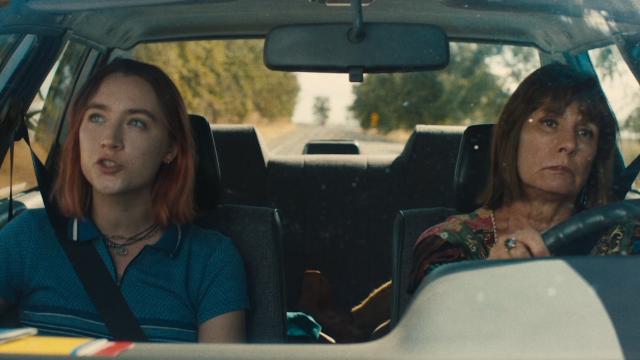Jorge's screenplay column hits its last Oscar mark for the season.

Lady Bird is less of a through-line narrative, as it is a collection of moments; a montage through the senior year of Christine “Lady bird” McPherson, and the small days and in-betweens that made it memorable. Through this collage, we are able to grasp at thematic links that run in her life, at the emotional truths she has to learn, and at the pain of watching her leave the nest.
No thread runs harder through the film than Lady Bird’s contentious relationship with her mother Marion. It’s no coincidence that the very first sequence of the film revolves around their dynamic. So let’s see how Greta Gerwig managed to infuse the emotional thesis of her film, as well as display years’ worth of a relationship in barely the first three pages of the script...
Lady Bird
Written by: Greta Gerwig
[You can read the full script here. I will be talking about these pages and this scene.]
The first paragraph of the scrip, which would later become the first shot of the movie, is of Lady Bird and Marion sleeping together in bed. Gerwig not only shows, but also clearly states in text that this will be a depiction of “a modern-day romantic Mary Cassatt rip-off painting of motherhood”). She also does not give Marion an age. It was perhaps too limiting, as giving her nothing but a vague description gives us the chance to plug our own mothers into Marion.
Lady Bird’s first line of dialogue is a question. This is something we will soon learn about her, that she has a questioning character. Not only is she constantly trying to learn and get more out of her life, but she most times does so by going against what the authority figures in her life tell her she should: her school superiors, her best friends, her mother.
The first thing Lady Bird does is question what her mother thinks of her, and how she does things. In less than a page, and less than a minute of on-screen time, we immediately know how she feels about her.

Next we see the car drive back from the college tour they just finished. They are listening to an audio book of The Grapes of Wrath, being and enjoying in the same moment together. As the tape finishes, “they laugh and then wipe their tears.” And they acknowledge that they had a nice moment, where they “shared the same emotion”.
But instability and rapid change is at the heart of their relationship, and the mood shifts as quick as Lady Bird tries to shift the song in the radio. Marion questions it by not questioning it directly (something we will later see Lady Bird is aware that is a thing she does, and hates it). And Lady Bird, like any teenager has done, gets annoyed and sullen. The shared moment is gone.

The car ride then escalates into a full argument, where the women are desperately trying to make themselves heard, without ever listening to each other. What starts as an angst-full cry from Lady Bird to “live through something”, escalates to a heated discussion about their family’s financial situation, the efforts put into having her in a safe school, her desire to go beyond, and Marion’s distrust about her daughter’s own abilities.
These are themes that will recur all throughout the movie. It’s clearly not the first time they’ve been brought up between them, and it certainly won’t be the last. In just one conversation, Gerwig gives us years’ worth of backstory in these characters. She does not use a lot action description through this. She is letting the characters speak for themselves. Her use of dual dialogue is sparse, but effective in portraying escalating tension.

***

The movie launches into full motion once Lady Bird jumps out of the car, and we cut to the title card. This informs us that this was just a teaser, the cold open for the film. But in just three pages, Greta Gerwig has already put forward the emotional groundwork for the whole movie. We have our main relationship established, and the tension between them. We have them openly express their fears, goals, and frustrations.
These three minutes are more full of story and character than most two-hour movies. And that’s the thing about Lady Bird. Every moment is packed with emotional truths. These are not flashy people; this is not Winston Churchill, or Katharine Grahame, or a fish monster. They are much more real. And that’s hella tight.